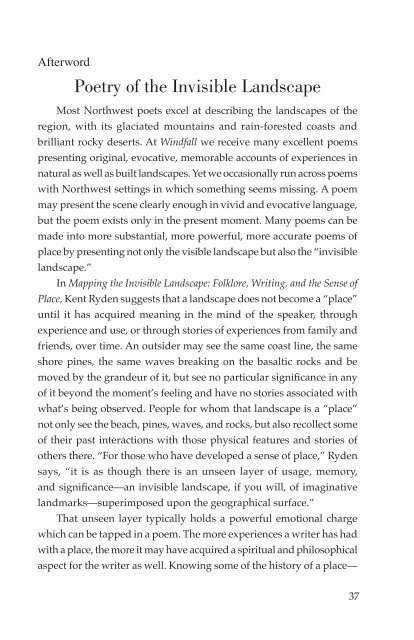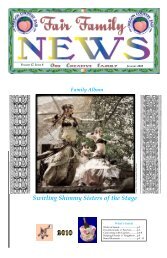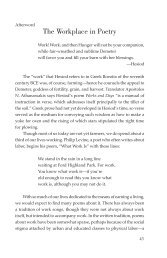Poetry of the Invisible Landscape - Hevanet Communications
Poetry of the Invisible Landscape - Hevanet Communications
Poetry of the Invisible Landscape - Hevanet Communications
You also want an ePaper? Increase the reach of your titles
YUMPU automatically turns print PDFs into web optimized ePapers that Google loves.
Afterword<strong>Poetry</strong> <strong>of</strong> <strong>the</strong> <strong>Invisible</strong> <strong>Landscape</strong>Most Northwest poets excel at describing <strong>the</strong> landscapes <strong>of</strong> <strong>the</strong>region, with its glaciated mountains and rain-forested coasts andbrilliant rocky deserts. At Windfall we receive many excellent poemspresenting original, evocative, memorable accounts <strong>of</strong> experiences innatural as well as built landscapes. Yet we occasionally run across poemswith Northwest settings in which something seems missing. A poemmay present <strong>the</strong> scene clearly enough in vivid and evocative language,but <strong>the</strong> poem exists only in <strong>the</strong> present moment. Many poems can bemade into more substantial, more powerful, more accurate poems <strong>of</strong>place by presenting not only <strong>the</strong> visible landscape but also <strong>the</strong> “invisiblelandscape.”In Mapping <strong>the</strong> <strong>Invisible</strong> <strong>Landscape</strong>: Folklore, Writing, and <strong>the</strong> Sense <strong>of</strong>Place, Kent Ryden suggests that a landscape does not become a “place”until it has acquired meaning in <strong>the</strong> mind <strong>of</strong> <strong>the</strong> speaker, throughexperience and use, or through stories <strong>of</strong> experiences from family andfriends, over time. An outsider may see <strong>the</strong> same coast line, <strong>the</strong> sameshore pines, <strong>the</strong> same waves breaking on <strong>the</strong> basaltic rocks and bemoved by <strong>the</strong> grandeur <strong>of</strong> it, but see no particular significance in any<strong>of</strong> it beyond <strong>the</strong> moment’s feeling and have no stories associated withwhat’s being observed. People for whom that landscape is a “place”not only see <strong>the</strong> beach, pines, waves, and rocks, but also recollect some<strong>of</strong> <strong>the</strong>ir past interactions with those physical features and stories <strong>of</strong>o<strong>the</strong>rs <strong>the</strong>re. “For those who have developed a sense <strong>of</strong> place,” Rydensays, “it is as though <strong>the</strong>re is an unseen layer <strong>of</strong> usage, memory,and significance—an invisible landscape, if you will, <strong>of</strong> imaginativelandmarks—superimposed upon <strong>the</strong> geographical surface.”That unseen layer typically holds a powerful emotional chargewhich can be tapped in a poem. The more experiences a writer has hadwith a place, <strong>the</strong> more it may have acquired a spiritual and philosophicalaspect for <strong>the</strong> writer as well. Knowing some <strong>of</strong> <strong>the</strong> history <strong>of</strong> a place—37
Some poems <strong>of</strong> place lose potential because <strong>the</strong>y focus soexclusively on <strong>the</strong> landscape and not on <strong>the</strong> invisible elements thatmake <strong>the</strong> landscape a “place.” The geographer Yi-Fu Tuan defines placeas “a center <strong>of</strong> meaning constructed by experience.” The experienceneedn’t have been <strong>the</strong> writer’s. And <strong>the</strong> experiences needn’t have beenremarkable. The experiences that create a sense <strong>of</strong> place, Tuan says,are “mostly fleeting and undramatic, repeated day after day and over<strong>the</strong> span <strong>of</strong> years. It is a unique blend <strong>of</strong> sights, sounds, and smells,a unique harmony <strong>of</strong> natural and artificial rhythms such as times <strong>of</strong>sunrise and sunset, <strong>of</strong> work and play. The feel <strong>of</strong> a place is registeredin one’s muscles and bones.” Incorporating <strong>the</strong>se elements into apoem give <strong>the</strong> poem its au<strong>the</strong>nticity, its sense that <strong>the</strong> author has <strong>the</strong>authority to speak. This sense <strong>of</strong> “day after day” repetition giving <strong>the</strong>speaker authority comes across clearly in Paul Hunter’s “The Deal” inthis issue <strong>of</strong> Windfall:He chops <strong>the</strong> ice for his horsesto drink maybe ninety times a yearthat when it’s thin enough<strong>the</strong>y break though for <strong>the</strong>mselveseven so when <strong>the</strong>y can <strong>the</strong>yreturn <strong>the</strong> favor working with a will<strong>the</strong>y pull <strong>the</strong>y back <strong>the</strong>y standbefore and after stand some morethough <strong>the</strong>y can’t toss down<strong>the</strong> hay for <strong>the</strong>mselves <strong>the</strong>y canmow waiting only <strong>the</strong> wordall knowing <strong>the</strong>y’re getting a dealIt’s not just <strong>the</strong> “ninety times a year” that suggests experience butalso <strong>the</strong> inductive logic at work: <strong>the</strong> speaker has experienced enoughinstances <strong>of</strong> <strong>the</strong>se undramatic events to feel confident at drawing a39
conclusion about how <strong>the</strong> horses must perceive this arrangement.Description <strong>of</strong> landscape takes a back seat, but we do learn that we’resituated where <strong>the</strong> wea<strong>the</strong>r is freezing for three months and horses areused for mowing fields.That repetition <strong>of</strong> experience over long periods <strong>of</strong> time is at <strong>the</strong> heart<strong>of</strong> <strong>the</strong> idea <strong>of</strong> place might suggest that a one-time visit to a mountaintopor public square or shoreline which moves us emotionally won’t lead toa strong poem <strong>of</strong> place. That’s not necessarily so, though experiencinga place only one time calls for compensating strategies. One approachto be wary <strong>of</strong> is <strong>the</strong> easy statement <strong>of</strong> amazement. In an interviewabout writing <strong>of</strong> place, Barbara Ras, director <strong>of</strong> Trinity University Press,puts her finger on <strong>the</strong> problem and points to <strong>the</strong> solution: “Writers aregetting more sophisticated and content-conscious. I’m not interestedin what Kim Stafford called ‘first-person rhapsodic’ because it’s justtoo bland and vapid.” She looks for <strong>the</strong> writer’s presentation <strong>of</strong> <strong>the</strong>invisible landscape, continuing, “I’m interested in something that’sgoing to deliver local lore and legend, culture, history, and naturalhistory—coherent useful knowledge that not only informs you about aplace but instructs you about how to be in <strong>the</strong> world.” A weekend visitoror a traveler zooming by on a highway can hardly begin to extract <strong>the</strong>essence <strong>of</strong> <strong>the</strong> place, even knowing <strong>the</strong> names <strong>of</strong> <strong>the</strong> physical features.It’s necessary to know what’s happened in a place. Without considerablepersonal experience <strong>of</strong> a place, <strong>the</strong> writer needs to learn more fromo<strong>the</strong>r sources. That may be from books, maps, or even photos, as withLex Runciman’s “Columbia River, Mitchell Point,” with its description<strong>of</strong> Carleton Watkins’ “silver mammoth albumen print.” Or it may befrom what those who have <strong>the</strong> place “in <strong>the</strong>ir muscles and bones” haveto say, which <strong>of</strong>ten comes through <strong>the</strong> local lore and legend, picked upmost easily in conversation.Ano<strong>the</strong>r strategy for first-time visits is to create experiences throughaction, ra<strong>the</strong>r than relying on passive description and admiration <strong>of</strong> <strong>the</strong>features <strong>of</strong> a place. The action itself may not be momentous; probably<strong>the</strong> more ordinary it is, <strong>the</strong> better. A glance at some <strong>of</strong> <strong>the</strong> poems in thisissue illustrate <strong>the</strong> technique: in Steve Hood’s “Frigid Winds,” “plastic40
hard hats” are carrying steel pipes and old timers are telling stories; inBill Mawhinney’s “Fungo King <strong>of</strong> Rialto Beach,” a man is walking <strong>the</strong>beach tossing stones into <strong>the</strong> air and hitting <strong>the</strong>m into <strong>the</strong> surf with apiece <strong>of</strong> driftwood as if hitting a baseball with a Louisville Slugger; inPepper Trail’s “Killing Barred Owls,” <strong>the</strong> speaker pulls <strong>the</strong> trigger <strong>of</strong>his gun to make a barred owl “explode / like a burst pillow”; in Eric leFatte’s “Lessons from Mt. Fricaba,” <strong>the</strong> two hikers practice inhaling andexhaling at high elevation by patterning <strong>the</strong>ir breathing after what <strong>the</strong>yobserve and “measure” at <strong>the</strong>ir alpine stopping-place. In each instance,people are interacting with <strong>the</strong> landscape, not passively describing.Some <strong>of</strong> <strong>the</strong>se comments on <strong>the</strong> “invisible landscape” may soundlike we’re advocating poems <strong>of</strong> more lived-in areas, ra<strong>the</strong>r than poemslocated in <strong>the</strong> natural world. Yes, and no: Poems <strong>of</strong> lived-in placesgenerally <strong>of</strong>fer <strong>the</strong> potential for a far greater complexity than poems<strong>of</strong> wild places because more people have had experiences <strong>the</strong>re, whichmeans a larger range <strong>of</strong> material to work with and thicker layers <strong>of</strong>meaning. We’d like to see more poems set in built landscapes, especiallypoems considering <strong>the</strong> more problematic relationship between peopleand nature in built landscapes. But wild areas work well for poems <strong>of</strong>place, too. People <strong>of</strong>ten bring <strong>the</strong>ir own culturally bred expectationsto a wild place, which means that <strong>the</strong> interaction between a poem’sspeaker and a “pristine” landscape typically engenders a ra<strong>the</strong>r limitedrange <strong>of</strong> reactions. This is where an acknowledgement <strong>of</strong> <strong>the</strong> “invisiblelandscape” can make <strong>the</strong> difference between an excellent poem <strong>of</strong> placeand a clichéd, predictable poem in which <strong>the</strong> speaker arrives, namessome flora and fauna and landforms, and in concluding expressesamazement.Even <strong>the</strong> most “pristine” landscape usually isn’t so pure andunspoiled, once more is learned about it. As Bill McKibben explains inThe End <strong>of</strong> Nature, <strong>the</strong>re is no place on earth that hasn’t been affected byhuman activity. In Eaarth, he asserts that we have altered <strong>the</strong> planet somuch, it’s no longer <strong>the</strong> earth we have always known. Human activityhas changed <strong>the</strong> atmosphere, <strong>the</strong> composition <strong>of</strong> <strong>the</strong> very air in every“natural” place, as well as world-wide wea<strong>the</strong>r patterns and <strong>the</strong> acidity41
<strong>of</strong> <strong>the</strong> oceans. Our heat waves and increasingly destructive storms arenow likely man-made phenomena. And yet, McKibben points out, wehave a considerable ability to shut out <strong>the</strong> radiation, carbon dioxidelevels, invasive species, and degraded landscapes from our mind, andsee only <strong>the</strong> beautiful scene we expect to see. When we haven’t layereda landscape with significance through repetitive experience or storiesfrom o<strong>the</strong>rs, <strong>the</strong> cultural stereotypes <strong>of</strong> <strong>the</strong> beauty <strong>of</strong> nature <strong>of</strong>tenobscure <strong>the</strong> reality in front <strong>of</strong> us.Many <strong>of</strong> <strong>the</strong> poems we publish in Windfall acknowledge <strong>the</strong>despoilment <strong>of</strong> a particular landscape, yet still reveal a layer <strong>of</strong> naturalbeauty. Laura Snyder’s “Grace” in this issue, for instance, lets us seewhat no longer is actually visible on <strong>the</strong> Tacoma shoreline <strong>of</strong> PugetSound, telling usThere are no ear<strong>the</strong>nbanks left to <strong>the</strong> river, no sustaining estuaries.The city <strong>of</strong> Tacoma claimed <strong>the</strong> marshland<strong>of</strong> <strong>the</strong> Puyallup River where it drainsinto <strong>the</strong> salt <strong>of</strong> Puget Sound.After <strong>the</strong>se and o<strong>the</strong>r reminders <strong>of</strong> <strong>the</strong> health that <strong>the</strong> landscape oncehad—an old man on <strong>the</strong> bench had once fished with a bamboo polehere—we look at <strong>the</strong> detritus <strong>of</strong> this landscape’s industrial reality today.And yet <strong>the</strong>re is beauty—<strong>the</strong> poem lets us see a third layer <strong>of</strong> meaning<strong>of</strong> <strong>the</strong> landscape, telling us “it is easy to lose sight / <strong>of</strong> what sustains us.This is <strong>the</strong> floodplain <strong>of</strong> Mt. Rainier.” Along with <strong>the</strong> man in <strong>the</strong> poem,we end by lifting our gaze to <strong>the</strong> “snow-fractured face” <strong>of</strong> Rainier. Intwenty-one lines <strong>of</strong> tercets, we have imagined a man’s experience with<strong>the</strong> landscape when it was healthy, we’ve seen it as is industrially, and<strong>the</strong>n seen it more geographically as a essential floodplain. Two <strong>of</strong> <strong>the</strong>three landscapes we’ve been shown would have been invisible to <strong>the</strong>outsider who arrived and simply looked.42
Human artifacts play an essential role in turning a landscapeinto a “place.” Much as we would like to think in terms <strong>of</strong> “pristine”landscapes and an independent natural world, <strong>the</strong> mining slag, <strong>the</strong>logging cables, and ceramic electrical insulators nailed to trees thatwe encounter in “wilderness areas” all suggest o<strong>the</strong>r, more interestingand more complex stories. The jet plane high overhead, <strong>the</strong> haze, <strong>the</strong>distant highway sounds, are all part <strong>of</strong> a place.Sometimes a human artifact provides <strong>the</strong> central meaning <strong>of</strong> apoem. In this issue’s poem “The Iron Chinks,” George Such uses <strong>the</strong>early twentieth-century machine that gutted and cleaned salmon inNorthwest canneries to capture an entire range <strong>of</strong> issues and attitudesabout machines replacing workers, immigration, and racism. The closedescription <strong>of</strong> <strong>the</strong> machine in <strong>the</strong> last line makes clear its role from aChinese-American perspective: “motor silent, pipes and faucets rusteddry, / but jaws open, teeth showing.”Perhaps <strong>the</strong> surest way to capture <strong>the</strong> flavor <strong>of</strong> a place is to choosewords that belong particularly to that place. In this issue alone, manypoems employ terms particularly tied to Pacific Northwest places,for landscape features—high tide, flood tide, estuary, rainforest, basalt,coulee, high desert, fumaroles, mist, glaciers, permafrost, muskeg; for flora—salmonberry, cedars, Douglas fir, hemlock, sagebrush, Ponderosa pine; forfauna—hermit and Swainson’s thrush, bittern, barred owl, spotted owl,jackrabbits, rattlesnakes, chum salmon, elk, caribou; for human artifacts—purse seines, gillnetters, crabbers, Iron Chinks. Then <strong>the</strong>re’s <strong>the</strong> naming <strong>of</strong>human activities that are particularly likely to be found in <strong>the</strong> PacificNorthwest: dry wheat farming, composting food scraps, climbingmountains, working on a ship in drydock, hiking a trail. These arewords <strong>of</strong> <strong>the</strong> language <strong>of</strong> Northwest places.Many intriguing terms for typical Northwest landscape featurescan be found in Barry Lopez and Debra Gwartney’s Home Ground:Language for an American <strong>Landscape</strong>. Entertaining, detailed, and veryreadable definitions <strong>of</strong> Northwest landscape terms have been writtenby such Northwest writers as Kim Barnes, John Daniel, John Keeble,43
William Kittredge, Robert Michael Pyle, Carolyn Servid, and KimStafford. Ryden says, ”Unlike simple geographical locations, whichexist objectively, places do not exist until <strong>the</strong>y are verbalized, first inthought and memory and <strong>the</strong>n through <strong>the</strong> spoken or written word.”These are terms that capture what Lopez calls our “homescape”: clearcut,krummholz, loess, rain shadow, sea stack, snow line, slash.Robert Lowell’s widely anthologized 1960 poem “For <strong>the</strong> UnionDead” demonstrates many <strong>of</strong> <strong>the</strong> ways in which <strong>the</strong> “invisiblelandscape” can add personal and historic resonance to a poem.Lowell uses St. Gaudens’ Shaw monument on Beacon Hill opposite<strong>the</strong> statehouse in Boston as <strong>the</strong> centerpiece for exploring <strong>the</strong> injusticeexperienced by African-Americans in <strong>the</strong> past and during <strong>the</strong> forcedschool desegregation occurring at <strong>the</strong> time in <strong>the</strong> South. The poemopens with <strong>the</strong> time and place made clear (winter, old South BostonAquarium), followed immediately by “<strong>the</strong> invisible landscape” which<strong>the</strong> aquarium conjures, from his childhood:The old South Boston Aquarium standsin a Sahara <strong>of</strong> snow now. Its broken windows are boarded.The bronze wea<strong>the</strong>rvane cod has lost half its scales.The airy tanks are dry.Once my nose crawled like a snail on <strong>the</strong> glass;my hand tingledto burst <strong>the</strong> bubblesdrifting from <strong>the</strong> noses <strong>of</strong> <strong>the</strong> cowed, compliant fish.The bubbles coming from <strong>the</strong> “cowed, compliant fish” providea central image <strong>of</strong> <strong>the</strong> poem, recurring when <strong>the</strong> speaker sees on <strong>the</strong>television set “<strong>the</strong> drained faces <strong>of</strong> Negro school-children rise likeballoons,” and when we’re told that “Colonel Shaw / is riding on hisbubble, / he waits / for <strong>the</strong> blessèd break.” At <strong>the</strong> end <strong>of</strong> <strong>the</strong> 68-linepoem, we return to <strong>the</strong> image <strong>of</strong> <strong>the</strong> fish which <strong>the</strong> long-ago aquariumhas provided <strong>the</strong> poem, and get a description <strong>of</strong> how things are now:44
The Aquarium is gone. Everywhere,giant finned cars nose forward like fish;a savage servilityslides by on grease.The opening “place” <strong>of</strong> <strong>the</strong> poem, <strong>the</strong> site <strong>of</strong> <strong>the</strong> old aquarium,provides “invisible” bubbles and fish that tie in to a long-dead CivilWar hero, school children accompanied by federal marshals, and <strong>the</strong>Eisenhower-era consumerist, conformist mentality. The rising bubblesare associated with <strong>the</strong> brave colonel and children, <strong>the</strong> lower-down fishwith everyone else.Three middle stanzas <strong>of</strong> humans interacting with nature close by<strong>the</strong> Shaw memorial even pull <strong>the</strong> Puritans <strong>of</strong> long-ago Massachusettsin <strong>the</strong> current redevelopment <strong>of</strong> Boston Common to accommodatemore giant cars:Behind <strong>the</strong>ir cage,yellow dinosaur steamshovels were gruntingas <strong>the</strong>y cropped up tons <strong>of</strong> mush and grassto gouge <strong>the</strong>ir underworld garage.Parking spaces luxuriate like civicsandpiles in <strong>the</strong> heart <strong>of</strong> Boston.A girdle <strong>of</strong> orange, Puritan-pumpkin colored girdersbraces <strong>the</strong> tingling Statehouse,shaking over <strong>the</strong> excavations, as it faces Colonel Shawand his bell-cheeked Negro infantryon St. Gaudens’ shaking Civil War relief,propped by a plank splint against <strong>the</strong> garage’s earthquake.The speaker is watching how <strong>the</strong> desire to accommodate evermore cars is gouging <strong>the</strong> common and shaking <strong>the</strong> statehouse andShaw memorial. What’s to preserve <strong>the</strong> older values <strong>of</strong> a common, a45
statehouse, and a monument to African-American soldiers and <strong>the</strong>irleader? For <strong>the</strong> statehouse, at least, <strong>the</strong> “invisible landscape” is a scene<strong>of</strong> Puritans and pumpkins, suggesting <strong>the</strong> first Thanksgiving, as if thosefounders <strong>of</strong> <strong>the</strong> first Massachusetts colony are supporting <strong>the</strong> statenow. In describing <strong>the</strong> place, Lowell’s metaphors imply o<strong>the</strong>r storieswe’re familiar with, <strong>of</strong> powerful dinosaurs going extinct and Puritanrigidity enabling survival.<strong>Poetry</strong> <strong>of</strong> place in some respects is a poetry <strong>of</strong> witness. A poemsays, “This place existed like this.” Sometimes <strong>the</strong> poem testifies to<strong>the</strong> ravages that have clearly been inflicted upon a place; sometimesit testifies to damage done long ago to a place which now gives scantevidence <strong>of</strong> it, as in Mary Ellen Talley’s “Trail <strong>of</strong> <strong>the</strong> Coeur d’AlenesSuperfund Site”; sometimes it testifies to <strong>the</strong> goodness <strong>of</strong> a place. Ineach instance, <strong>the</strong> poem exerts more power, gets closer to <strong>the</strong> complexity<strong>of</strong> reality, and makes <strong>the</strong> place more significant when it recognizes<strong>the</strong> layers <strong>of</strong> stories in <strong>the</strong> “invisible landscape” and enables <strong>the</strong>m toreverberate throughout <strong>the</strong> poem.—Bill Siverly and Michael McDowellWorks Referred to in This Afterword:Robert A. Davies. “Timber Wea<strong>the</strong>r.” Windfall 11.1 (2012): 7.Ernest Hemingway. Interview. Writers at Work: The Paris ReviewInterviews. 2 nd series. Ed. George Plimpton. New York: Viking,1963. 215-39.Steve Hood. “Frigid Winds.” Windfall 11.1 (2012): 34.Paul Hunter. “The Deal.” Windfall 11.1 (2012): 18.Eric le Fatte. “Lessons from Mt. Ficaba.” Windfall 11.1 (2012): 27.Barry Lopez and Debra Gwartney, eds. Home Ground: Language for anAmerican <strong>Landscape</strong>. San Antonio: Trinity University Press, 2006.Robert Lowell. “For <strong>the</strong> Union Dead.” The Norton Anthology <strong>of</strong> <strong>Poetry</strong>.5 th ed. Ed. Margaret Ferguson, Mary Jo Salter, and Jon Stallworthy.New York: Norton, 2005. 1603-05.Bill McKibben. Eaarth: Making a Life on a Tough New Planet. New York:Times-Henry Holt, 2010.46
Bill McKibben. The End <strong>of</strong> Nature. New York: Anchor-Doubleday, 1989.Bill Mawhinney. “The Fungo King <strong>of</strong> Rialto Beach.” Windfall 11.1(2012): 25.Barbara Ras. Quoted in Ann Wendland, “Whi<strong>the</strong>r Writing <strong>of</strong>Place?: Perspectives on Publishing Personal Essays on Natureand Environment.” The Exchange. Quarterly Newsletter <strong>of</strong> <strong>the</strong>Association <strong>of</strong> American University Presses. Spring 2003. 2-4.Lex Runciman. “Columbia River, Mitchell Point.” Windfall 11.1 (2012):15.Kent C. Ryden. Mapping <strong>the</strong> <strong>Invisible</strong> <strong>Landscape</strong>: Folklore, Writing, and <strong>the</strong>Sense <strong>of</strong> Place. Iowa City: University <strong>of</strong> Iowa Press, 1993.Laura L. Snyder. “Grace.” Windfall 11.1 (2012): 23.George Such. “The Iron Chinks.” Windfall 11.1 (2012): 33.Mary Ellen Talley. “Trail <strong>of</strong> <strong>the</strong> Coeur d’Alenes Superfund site.” Windfall10.1 (2011): 32.Pepper Trail. “Killing Barred Owls.” Windfall 11.1 (2012): 14.Yi-Fu Tuan. “Place: An Experiential Perspective.” Geographical Review65 (1975): 151-65.Yi-Fu Tuan. Space and Place: The Perspective <strong>of</strong> Experience. Minneapolis:University <strong>of</strong> Minnesota Press, 1977.47






